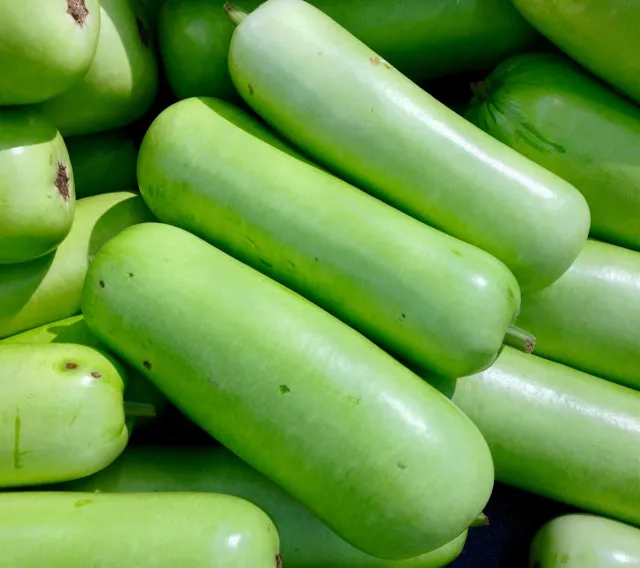Table of Contents
Opo Squash (Bottle Gourd): A Global Vegetable With Local Flavors
Overview & Names
Opo squash, commonly known as bottle gourd, is a long, light green vegetable popular in Asian, African, and Caribbean cuisines. Scientifically known as Lagenaria siceraria, it goes by various names:
- India: Lauki, Doodhi, Sorakaya
- China: Hu lu gua (葫芦瓜)
- Philippines: Upo
- Africa: Calabash
- Caribbean: Long squash
- Middle East: Kadoo
Varieties
Opo squash comes in several shapes and sizes, including:
- Long, cylindrical types (most common for cooking)
- Round or bulbous types (used for both cooking and utensil-making)
- Hybrid varieties bred for pest resistance and high yield
Nutrition Profile (per 100g, raw)
- Calories: 14 kcal
- Water: 92–95%
- Carbs: 3.5g
- Protein: 0.6g
- Fat: 0.1g
- Fiber: 1.2g
- Vitamins: Vitamin C, B6, folate
- Minerals: Calcium, magnesium, potassium
It's low in calories and high in water, making it excellent for hydration, weight loss, and heart health.
Texture, Smell, and Flavor
- Texture: Smooth, firm outer skin with soft, spongy inner flesh when cooked. Seeds may be tender or hard, depending on maturity.
- Smell: Mild, grassy aroma when raw; neutral to slightly earthy when cooked.
- Flavor: Very mild and subtly sweet—readily absorbs the flavor of spices and other ingredients it is cooked with.
How to Eat Opo Squash
- Raw: Thinly shredded or sliced in salads (young and tender squash only)
- Cooked:
- Stews & Curries: Absorbs spices and balances heat
- Soups: Adds body and bulk
- Stuffed & Baked: Often filled with spiced lentils or meat
- Fritters & Koftas: Grated, spiced, and fried
- Juice: Consumed in Ayurvedic diets for liver detox and digestion
Culinary Uses
- India: Lauki curry, lauki kofta, lauki halwa
- China: Stir-fries with garlic and soy
- Philippines: Upo with shrimp or pork in brothy stews
- Middle East: Stuffed with rice, meat, and spices
Allergies and Considerations
- Generally safe, but bitter bottle gourd may contain toxic compounds called cucurbitacins, which can cause stomach issues.
- Always taste a small piece raw—if bitter, discard immediately.
- Rare allergies may cause itching or rash.
Glycemic Index
- Opo squash has a very low glycemic index (GI < 15), making it ideal for diabetic diets.
Producing Countries
- Top producers:
- India (major global leader)
- China
- Bangladesh
- Vietnam
- Philippines
- Egypt
- It is cultivated in tropical and subtropical climates around the world.
Cultivation & Annual Output
- Requires warm temperatures, moderate rainfall, and well-drained soil.
- Grown as an annual vine crop and harvested 2–3 months after sowing.
- Annual output (estimated): Over 5 million metric tons globally, with India contributing the majority share.
Global Availability & Acceptance
- Widely accepted in Asia, Africa, and Middle East; gaining popularity in Western countries for its health benefits.
- Readily available in ethnic and organic markets in North America and Europe.
- Increasing use in vegan and plant-based diets.
Farms & Major Producers
- India: Uttar Pradesh, Maharashtra, Bihar, Andhra Pradesh
- China: Guangdong, Fujian, Guangxi
- Bangladesh: Dhaka, Rajshahi
- Large-scale organic farms have started exporting to the U.S., U.K., and Gulf countries.
Price Trends
- Local markets: $0.30–$1.00 per kg in producing countries
- Export markets: $2.00–$5.00 per kg depending on region and season
- Price fluctuates based on monsoon patterns, transport, and international demand.
Future Outlook & Climate Impact
- Global warming may affect opo squash yields due to increased pest infestation and extreme temperature swings.
- However, drought-tolerant hybrid varieties are under development.
- Its low water footprint and versatility make it a sustainable crop for the future.
- The future is promising, especially with growing interest in plant-based diets, food security, and traditional medicines.





